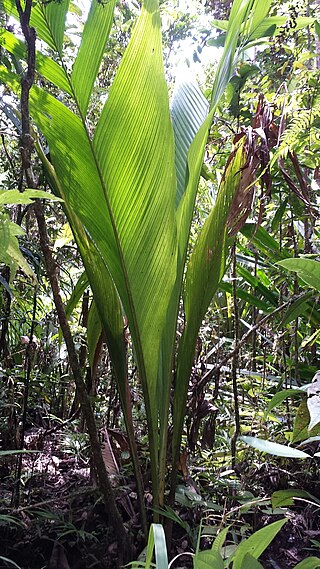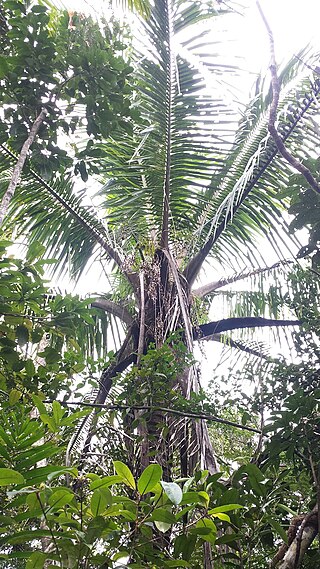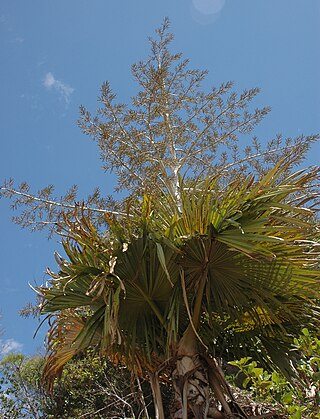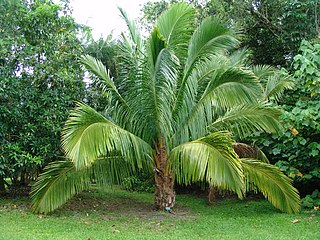
Dypsis decaryi is a species of flowering plant in the Arecaceae family. It is commonly known as the triangle palm. It is indigenous to the Madagascan rainforest. Some specimens grow to a height of some 15 metres (49 ft) in the wild. It is relatively new to cultivation however, so outside its native habitat it rarely achieves anything like that height. The leaves are about 2.5 metres in length, growing almost upright from the trunk and arching gracefully outward about a metre from their tips. The leaf bases are arranged in three vertical columns set about 120 degrees apart on the main stem, forming a triangular shape in cross section. This shape has given rise to the palm's common name.
Dypsis ampasindavae is a species of palm tree. It is endemic to Madagascar. It is native to the Sambirano region of northwestern Madagascar, where it is found in subhumid lowland forest from sea level to 300 meters elevation. It is known from only two locations, and there are fewer than 30 mature individuals between them.

Dypsis decipiens, the Manambe palm, is a species of flowering plant in the Palm family (Arecaceae). It is found only in the central highlands of Madagascar, between Fianarantsoa and Andilamena at 1,200 to 1,700 meters elevation. The species is threatened by habitat loss, increasing frequency of fires, and over-exploitation of its seeds for the horticultural trade. Its most unique characteristic is that it commonly produces twin trunks like the letter "V", each trunk being up to 65 feet in height and up to 28 inches DBH. There can also be three trunks, or a single trunk.
Dypsis onilahensis is a species of palm tree in the family Arecaceae. It is endemic to Madagascar as is reflected in the species name (onilahensis) referring to the Onilahy River, south of Toliara. It is threatened by habitat loss.
Dypsis singularis is a species of flowering plant in the Palm Family. It is found only on the island of Madagascar. It is threatened by habitat loss. It is remarkable for its height to width ratio; the greatest of any tree. It is up to 19ft 8in tall while being only 2/5ths of a inch in diameter, a length/width ratio of 600 fold.

Lemurophoenix halleuxii is a species of palm tree, the only species in the genus Lemurophoenix. It is found only in Madagascar. It is threatened by habitat loss and overcollection. There are perhaps 300 mature individuals remaining in the wild.

Marojejya is a genus of flowering plant in the family Arecaceae. It contains the following two species, both endemic to Madagascar:

Masoala kona is a species of flowering plant in the Palm Family. It is a palm endemic to Madagascar, where it grows in rainforests. There are fewer than 60 individuals estimated to remain. Its most remarkable feature is that its leaves bear the longest "segments" of any plant; up to 8.2 feet in length. A leaf segment has a broad attachment to the rachis rather than a petiolule. It differs from a lobed leaf in that the lamina (leaf) is not continuous. The species is threatened by habitat loss.

Orania ravaka is a species of flowering plant in the family Arecaceae.
Ravenea musicalis, or the river palm, is a species of flowering plant in the family Arecaceae. Also known by the Antanosy word "torendriky," meaning "submerged trunk", R. musicalis is known for being the only truly aquatic palm tree. Like many mangrove trees, R. musicalis seeds germinate within the fruit, and the seedling takes root underwater. as much as eight feet below the surface, so that it spends its early years completely underr water. Endemic to Madagascar, R. musicalis was first discovered in 1993 by Henk Beentje on an expedition funded by the McDonald's restaurant. although of course it was ethnoknown by the Antanosy People for centuries. This palm is listed in the IUCN Red List. This tree is harvested by local people primarily for building material and food. Over-harvesting, habitat degradation and habitat loss threaten the remaining populations. Horticulturalists prize R. musicalis for its rarity and unique life history.

Ravenea xerophila is a solitary medium-sized palm in the family Arecaceae. It is found only in southern Madagascar, and is threatened by habitat loss. Trees grow from 1.5–8 meters in height, and 13–30 cm in diameter.

Satranala decussilvae is a species of flowering plant in the Arecaceae family. It is a palm endemic to Madagascar. It is the only species in the genus Satranala, and is threatened by habitat loss. There are perhaps 200 mature individuals remaining.

Voanioala gerardii, commonly known as the forest coconut, is a species of flowering plant in the family Arecaceae. It is a relative of the coconut, and is generally regarded as monotypic within the genus Voanioala. However, a team of geneticists headed by Bee F. Gunn found sufficient genetic variation within Voanioala to constitute at least two and possibly four cryptospecies. Voanioala is endemic to Madagascar, and is threatened by habitat loss. Voanioala is harvested for its edible seeds and palm heart. It is estimated that there are fewer than 15 mature trees remaining.

Bismarckia is a monotypic genus of flowering plant in the palm family endemic to western and northern Madagascar, where it grows in open grassland.

Tahina spectabilis, the tahina palm, also called blessed palm or dimaka is a species of gigantic palm that is found only in the Analalava District of northwestern Madagascar where its range is only twelve acres, one of the most extreme examples of endemism known. It can grow 18 m (59 ft) tall and has palmate leaves over 5 m (16 ft) across. The trunk is up to 20 in (51 cm) thick, and sculpted with conspicuous leaf scars. An individual tree was discovered when in flower in 2007; it was first described the following year as a result of photographs being sent to Kew Gardens in the United Kingdom for identification. The palm is thought to live for up to fifty years before producing an enormous inflorescence up to 19.5 ft (5.9 m) in height and width, surpassed in size only by Corypha spp. and by Metroxylon salomonense and, being monocarpic, subsequently dying. The inflorescence, a panicle, consists of hundreds, perhaps thousands, of three-flowered clusters which bloom in three consecutive, synchronized "cohorts" or flushes of bloom. The nearest equivalent pattern of flowering is in the flowering vine Bougainvillea where the three flowers bloom sequentially, but not synchronized. Fewer than one hundred adult individuals of the species are thought to exist and the International Union for Conservation of Nature has rated it as "critically endangered".

Beccariophoenix madagascariensis, commonly known as the coastal beccariophoenix, is a species of flowering plant in the family Arecaceae. It is a large Coconut relative that is vulnerable in its habitat in Madagascar.

Beccariophoenix alfredii, also known as the high plateau coconut palm, is a recently discovered species of Arecaceae (palms), endemic to Madagascar. It is in the genus Beccariophoenix, and is closely related to the genus Cocos. Beccariophoenix alfredii is very similar in appearance to the coconut palm, although somewhat cold hardy, making it a good look-alike for the coconut in cooler climates.
John Dransfield is an honorary research fellow and former head of palm research at the Royal Botanic Gardens, Kew, United Kingdom, as well as being an authority on the phylogenetic classification of palms.

Ravenea beentjei is a species of palm tree. It is endemic to Madagascar, where it grows in a frequently flooded area within a single locality of southeast Madagascar called Vondrozo. There are only about 40 mature trees known in their natural range. Like the majority of species in the Ravenea genus, it requires ample freshwater to survive. Therefore, it grows in valleys and swampy areas within the lowland tropical and subtropical moist broadleaf forests that carpet eastern Madagascar.

Ravenea hypoleuca is a species of palm tree. It is endemic to Madagascar, where it grows in two locations within southeast Madagascar; One is near a town called Vondrozo and the other near Tsitongambarika. There are only about 40 mature trees known in their natural range.
















